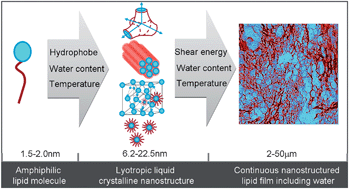Water-in-oil nanostructured emulsions: towards the structural hierarchy of liquid crystalline materials†
Abstract
We present novel

* Corresponding authors
a
Department of Chemistry, University of Graz, Heinrichstrasse, 28, Graz, Austria
E-mail:
chandrashekhar.kulkarni@uni-graz.at, otto.glatter@uni-graz.at
Fax: +43 (0)316 380 9850
Tel: +43 (0)316 380 5433
b
Institute of Food, Nutrition and Health, ETH Zurich, Zurich, Switzerland
E-mail:
raffaele.mezzenga@agrl.ethz.ch
Fax: +41 (0)44 632 16 03
Tel: +41 (0)44 632 91 40
We present novel

 Please wait while we load your content...
Something went wrong. Try again?
Please wait while we load your content...
Something went wrong. Try again?
C. V. Kulkarni, R. Mezzenga and O. Glatter, Soft Matter, 2010, 6, 5615 DOI: 10.1039/C0SM00515K
To request permission to reproduce material from this article, please go to the Copyright Clearance Center request page.
If you are an author contributing to an RSC publication, you do not need to request permission provided correct acknowledgement is given.
If you are the author of this article, you do not need to request permission to reproduce figures and diagrams provided correct acknowledgement is given. If you want to reproduce the whole article in a third-party publication (excluding your thesis/dissertation for which permission is not required) please go to the Copyright Clearance Center request page.
Read more about how to correctly acknowledge RSC content.
 Fetching data from CrossRef.
Fetching data from CrossRef.
This may take some time to load.
Loading related content
